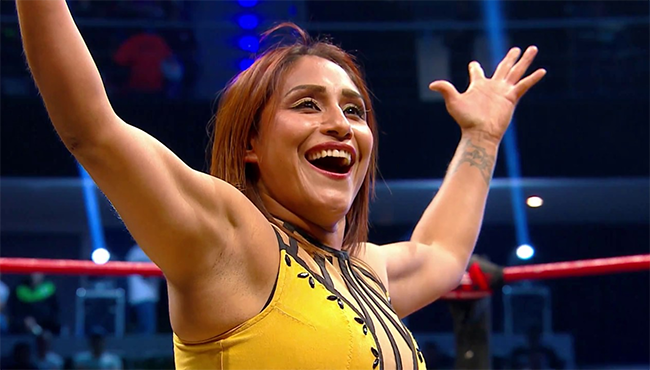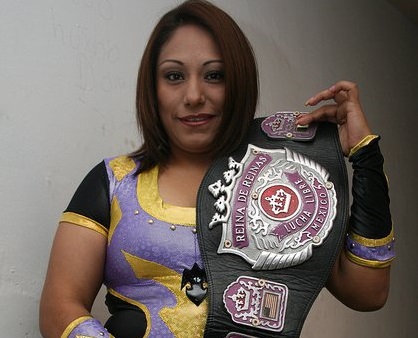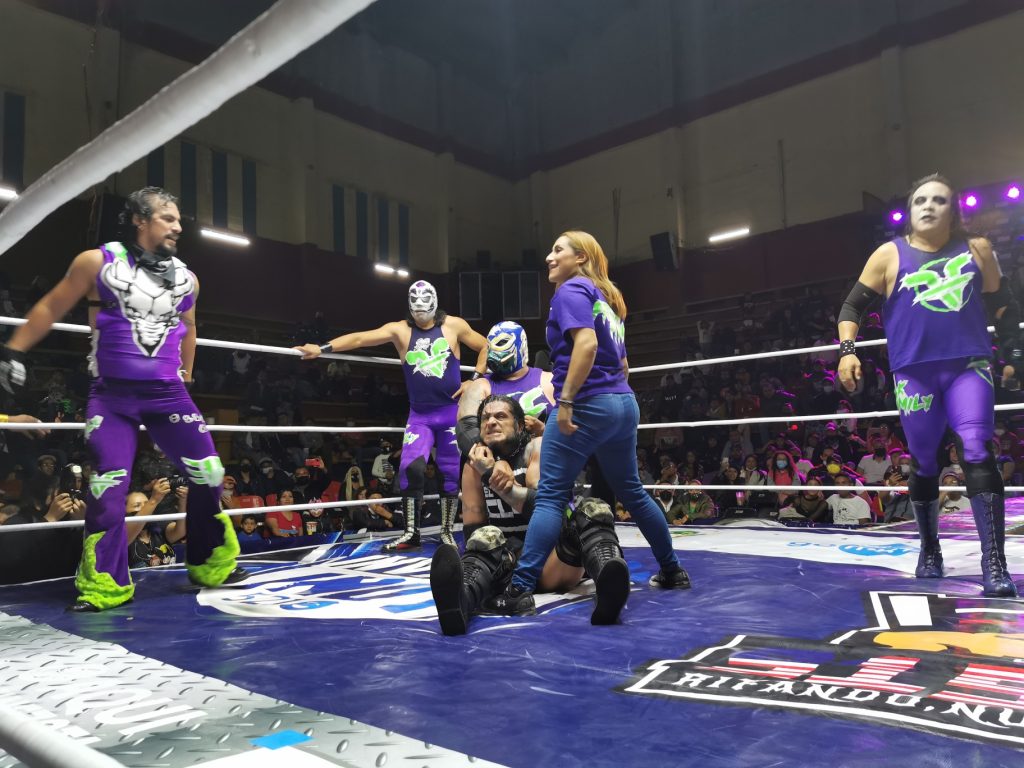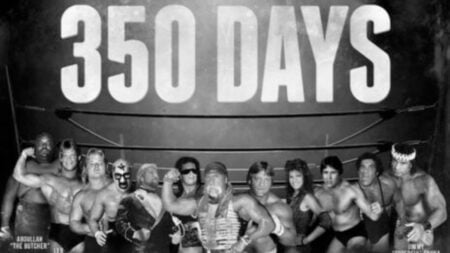The landscape of pro wrestling in Mexico is dominated by wrestling families. No matter the era, it’s hard to find pro-wrestlers in Mexico that aren’t related in some way to another one.
And when one pro-wrestler finally hangs up their boots, then there’s usually a Jr. or an El Hijo ready to take over from where they left off. Gran Apache’s case was no different.
From his debut for UWA (Universal Wrestling Association) in 1985 through to his final match in 2016, Gran Apache was respected by talent and fans alike as both a fantastic in-ring competitor and a trainer.
Despite originally dreaming of being a part of a salsa band until he met the Blue Comets and the legendary luchador El Santo.
Apache Family Legacy – The Women of the Apache Family
At only 5’6, Gran Apache may never have been destined to be the biggest star in Mexican wrestling, but he made a name for himself across the country nonetheless, achieving the same level of respect in Japan with multiple promotions from the nineties onwards.
Though, the career of Gran Apache is not just defined by his own efforts. Gran Apache’s family were ever-present throughout his career.
From the early days when he would train with his then-wife, Lady Apache, to teaming with his daughters and being a part of their own careers.
To truly appreciate the career of Gran Apache, we should look at the women most present in his life, who have proven to be superb talents in their own rights and cemented themselves as some of the top female stars in Mexican pro-wrestling history.

Lady Apache
Lady Apache was the ring name of Sandra González Calderón, who started using the name after she began training in 1986 at the age of fifteen in hopes of having a pro-wrestling career, training under Gran Apache, who hadn’t started his own career much earlier.
She was able to use the Apache name not just because she was a student of Gran Apache but because the two started a romantic relationship together shortly after she had started her journey.
Though she made her in-ring debut that year in Veracruz against Ultravioleta, she took some time after falling pregnant with her and Gran Apache’s daughter Nancy.
She would quickly return a year later to act as a valet for Gran Apache and his tag partner, Luis Vergara.
The three of them formed a faction that played into their gimmick and culture. However, it would disband after five years in the Mexican indies when Gran Apache & Lady Apache were snatched up by the biggest promotion in Mexico, EMLL (Empresa Mexicana De La Lucha Libre) full-time just before the promotion’s rebrand into CMLL during a year which saw an exodus of EMLL talent to the newly formed Lucha Libre AAA.
Lady Apache’s early CMLL career consisted primarily of tag team and trios matches, often featuring Xochitl Hamada – another female star in Mexico with a famous family.
Even though Lady Apache did not find immediate success on CMLL’s women’s roster, she did find herself in a match for the vacant Mexican National Women’s Championship, which has been the longest-active women’s championship in the promotion and likely the country after its inception in 1955.
The match came about after she and her opponent in the match, La Diabolica, won a Torneo Cibernetico (an intricate bout where two teams aim to eliminate the opposing team and then battle it out amongst the remaining competitors).
Unfortunately for Lady Apache, it was not to be, and she found herself on the losing end to La Diabolica. This would not be the end of their feud however.
The two fought again in a championship match with the same result occurring. In 1994, women’s wrestling from Mexico came to Japan for Genichiro Tenryu’s WAR (Wrestle Association-R) promotion.
There, the two would go to war all over Japan throughout September and October, with Lady Apache coming out on top more often than not.
She would return to Japan early the following year with Japan’s premium joshi wrestling promotion AJW (All-Japan Women’s Pro-Wrestling), where she would team with the young La Felina in a tournament for the WWWA Tag Team Championships, losing in the quarter-finals.
When Lady Apache returned back home to Mexico and CMLL, the CMLL World Women’s Championship was up for grabs. Reina Jubuki, better known as Akira Hokuto, had just left the promotion to appear on WCW Monday Nitro after an 800+ day reign as champion.
With the title vacant, a tournament between the top women in CMLL was announced to crown the next champion and it would be Lady Apache who was crowned in November 1996 after victories over Xochitl Hamada and Chaparita Asari.
Her title victory in 1996 would not be the victory that defined her career. She wouldn’t make a single successful defence of the CMLL World Women’s Championship and lost the title four months after winning it to ARISON’s Mariko Yoshida.
She would have to wait for Yoshida to officially leave Mexico in 1999 to capture the belt yet again at a Toryumon event. Lady Apache’s second run with the belt would last over a year, where she would compete across Mexico and in Osaka, Japan.
Like many champions in CMLL, she would defend her hair more than her title, putting her locks on the line in Luchas de Apuestas against La Mohicana and Tania La Guerrillera, who both had their hair shaved after losing to Lady Apache.
She would leave CMLL at the turn of the century, vacating her CMLL World Women’s Championship ahead of her next venture with Lucha Libre AAA, where her husband had worked as a wrestler and later head trainer for five years.

Mary & Faby Apache
Before Gran Apache started his relationship with Lady Apache, he had already became a father to two girls who would follow in his footsteps to become professional wrestlers. Mary (Mariella) Apache was the firstborn in 1979, followed by Faby (Fabiola) a year later.
Mary would be first to debut in Lucha Libre AAA’s women’s division in 1996, originally as Princesa Apache before briefly adopting the masked persona – Love.
Her name would once again change to Lady Venum so that she could form a stable called Las Cadetas del Espacion with Lady Discovery and Lady Luxor as an offshoot of a male stable already active in AAA.
The stable would be extremely short-lived and only seemed to exist for the purpose of advancing Xochitl Hamada’s push at Guerra de Titanes.
The Lady Venum gimmick would be passed to Mary’s younger sister, Faby, for her debut in Mexico, but the character had little impact on either of their futures.
It’s no secret that women’s wrestling in Japan was on another level to many other countries.
The eighties were a boom period for Joshi wrestlers, and following the decline of AJW in the later nineties, spaces for new promotions where women were the focus popped up everywhere.

In 1998, both Mary and Faby would debut for ARISON in Japan, where they would receive training from Mariko Yoshida and Aja Kong. They would team together against each other and face a variety of established talent in respective singles matches.
They even faced each other for the first time at Starlight in their debut year with Mary coming out as the winner.
All of these matches would help to build them for their appearance in the Twin Stars of ARISON League where they would compete as a tag team against a host of other women to crown the first Twin Stars of ARISON Champions.
The two would stay in ARISON for four years, with sporadic appearances for both CMLL and AAA. In ARISON, they both won their first championship – the Sky High of ARISON Championship.
This championship would come to Mary first, who defeated Chaparita Asari for the title in the year 2000 before losing it to Ayako Hamada in Nagoya.
Faby Apache then won a tournament for the vacant championship in 2001 after defeating Noki-A (better known as Akino) in the final, though Faby would drop the belt to her a few months later at ARISON’s fourth-anniversary show.
The end of their time in ARISON would mark the end of Mary and Faby’s time as partners in the ring for a number of years. Mary would take a break from professional wrestling after ARISON as she was pregnant with her daughter, Natsumi, who was born in 2003.
Faby Apache, on the other hand, would appear for JWP (Japanese Women Pro-Wrestling Project) and even New Japan Pro Wrestling before making her return to Mexico with AAA in 2002.

Lady Apache & Mr. Elektro
For the first time, Gran Apache found himself in the same promotion as two others that used the Apache name. Lady Apache and Gran Apache divorced in the early ’00s, moving on to marry Brazo de Oro and later Electroshock (better known as Mr. Elektro).
Even so, she kept her ring name as she had turned it into a household name for women’s pro wrestling in Mexico, having come a long way since being a valet for her now ex-husband.
By the time that Faby Apache appeared back in AAA, Lady Apache had already captured the AAA Reina de Reinas Championship, the top women’s championship in the promotion, after defeating then-champion Rossy Moreno as well as Miss Janeth and Tiffany in a four-way match.
She even appeared in ARISON to successfully defend the title against Faby during the reign which spanned a year. Just as Lady Apache had gained the AAA Reina de Reinas in a four-way match, she lost it in the same manner when Esther Moreno picked up the championship.
Lady Apache wouldn’t be left without a championship for long, though as she reclaimed the Mexican National Women’s Championship (which could now also be defended on AAA shows) during a feud with Tiffany, which saw the two go back and forth over the title for over a year.
The AAA Reina de Reinas Championship was also dragged into the feud after Tiffany won a tournament for the title.
During this feud, it became public knowledge that Lady Apache had married Electroshock, and so AAA sought to recognize the relationship on-screen.
The two would team together in a mixed-gender tag team tournament in a bid to become the first-ever AAA World Mixed Tag Team Champions at Triplemania IX.

Lady Apache and Electroshock defeated the team of her ex-husband Gran Apache and his daughter Faby Apache, as well as Tiffany and her tag team partner Chessman, in the finals to claim the championships.
The feud between Lady Apache and Tiffany seemed to culminate in February 2004 where Tiffany, who held both the AAA Reina de Reinas Championship and the Mexican National Women’s Championship and, put them both on the line against Lady Apache, with Lady Apache claiming victory and both championships.
Her reign with the AAA Reina de Reinas Championship lasted until Tiffany reclaimed the title just over a year after losing it.
But Lady Apache’s Mexican National Women’s Championship reign would last over three years with sporadic defences throughout.
Yet even then, the feud wasn’t over. Shortly after Lady Apache and Electroshock picked up the AAA World Mixed Tag Team Championships, they were challenged once again by Tiffany and Chessman, where the latter team would pick up the victory in the title match.
In a form of almost poetic justice, the pair that would take championship gold out of the equation for the feuding teams would be Lady Apache’s ex-husband, Gran Apache, and his daughter, Faby.
They would hold on to and defend the championships for almost a year against various teams, though they would defend them multiple times against the team of Cynthia Moreno and El Oriental until the titles were unexpectedly vacated in 2005.
At long last, the feud between Lady Apache, Electroshock, Tiffany, and Chessman had arrived at a point where the two teams could no longer feud over championships and instead had one final tag team match at Rey de Reyes where the losing team would have to disband as per Pareja Suicidas rules.
The losing team would also have to face each other in a hair vs hair match. Lady Apache and Electroshock lost the match and would reluctantly have to face each other with one losing their hair at the end of the match.
With both sets of hair on the line, Electroshock pinned his wife but pleaded with the officials to shave his hair off instead of hers. In the end, the officials agreed and shaved Electroshock’s hair off.
This would not go down well with Electroshock’s brother, Charly Manson, who was not happy that Electroshock would sacrifice his own hair despite winning. The two’s feud would escalate to a point where they both put their careers on the line when they faced each other at Triplemania XII.
Electroshock lost; his career was set to end there and then until Faby Apache begged Manson to revoke the stipulation that the loser had to retire in exchange for being shaved bald as she should have been in her match against her husband.
Manson agreed, instead choosing to shave Lady Apache bald as well as her husband once again. This would be Lady Apache’s last major feud in AAA as she returned to CMLL to once again capture the biggest prize CMLL had to offer their women’s division.

Faby Apache & Billy Boy
As one feud ended, another began. This time it would involve Faby Apache and her real-life husband Billy Boy, though the fans were not to know that the two had wed. The relationship was first used on TV when Billy Boy attempted to woo Faby with flowers and the like during her matches.
Eventually, Faby gave in to Billy Boy’s attempts at charm, and the two started dating on-screen. Their connection did not go down well with her father, Gran Apache (on-screen), who deemed Billy Boy to be unworthy of his daughter and attacked him.
This rivalry between Gran Apache and Billy Boy would span multiple years, with Gran Apache seeking to ruin Billy Boy for corrupting his daughter. He would defeat Billy Boy in a match that saw Billy Boy forced to stay far away from Faby, much to Gran Apache’s delight.

Just when everyone thought the story between Billy Boy and Gran Apache was over, with Gran Apache victorious, a mysterious masked luchador named Alfa debuted in AAA and befriended Gran Apache.
Gran Apache went as far as to say that Alfa would make a good husband for his daughter Faby, a statement he soon retracted when Alfa unmasked to reveal that he was Billy Boy all along.
Once Billy Boy had returned as himself, he attacked Faby Apache after she slapped him. This, as expected, did not go down well with Gran Apache who was then attacked by Billy Boy and written off TV due to his knee injury.
From there, Billy Boy would develop an on-screen relationship with AAA’s top rudo (heel) Sexy Star, while Faby Apache did the same with Aero Star. A cage match between the four ended with Faby pinning Billy Boy to set up for a feud between herself and Sexy Star.

The Return of Mary Apache
Five years after giving birth to her daughter Natsumi, Mary Apache made her return to professional wrestling with AAA to support her father and her sister Faby in their feuds. Notably, she would frequently pair with her father to take on Faby and Billy Boy during Gran Apache’s feud with Billy Boy.
Her involvement in the feud would lead to her winning the AAA World Mixed Tag Team Championships with her father but also losing her hair to her sister and then AAA Reina de Reinas champion Faby.
After being forced to become a maid for the locker room by Sexy Star, Mary Apache would defeat Sexy Star for the AAA Reina de Reinas Championship after pinning her in a multi-person tag team match where a number of different championships were on the line.
She held the championship for just under a year before she was eliminated by Pimpinela Escarlata in a title defense.
She would not claim the championship again, though her sister Faby would be champion three more times, notably keeping the title for over 500 days until Taya Valkyrie came knocking.
Natsumi Apache
As Lady, Faby, and Mary began to make more sporadic appearances across the indies and for various other promotions, another Apache had started her foray into professional wrestling.
In 2017, Mary Apache sent her daughter Natsumi to Japan to train as a professional wrestler, much as Gran Apache had done with her two decades prior.
Natsumi had expressed a desire to be part of the family business and run the ropes after Gran Apache’s passing earlier in the year, though she did not want to use the Apache name until she felt as though she had earned it.
Mary went with her two Japan, and they competed in Japan’s premiere Joshi promotion – World Wonder Ring Stardom. Natsumi would make her Stardom debut in 2018 as part of a new wave of young Joshis.
Here, she would become part of the STARS faction, which consisted of many future stars of the promotion, such as Starlight Kid and Tam Nakano. Come 2019, Natsumi was no longer making appearances for Stardom and instead worked on the Mexican independent scene.
She showed the promise that the other women in her family did during the early stages of their careers and certainly made a strong case for herself to continue that family legacy. It remains to be seen what impact she will have on the future of professional wrestling should she choose to continue her career.
The Legacy They Will Leave Behind
The women of the Apache family have had plenty more matches than the ones mentioned here, but it was their ability to combine wrestling with romance and storytelling that complimented their in-ring abilities and made them stand out in a scene full of colorful characters.
These women were not just the family of Gran Apache. He may have helped start their careers, but Lady, Faby and Mary have made the Apache name a household one in Mexican and even Japanese wrestling. This was cemented when the trio won the women’s division of the 2016 Lucha Libre World Cup together.
When we look at wrestling in Mexico, the Apache women have ensured that the Apache name will continue to be mentioned for some time to come.





